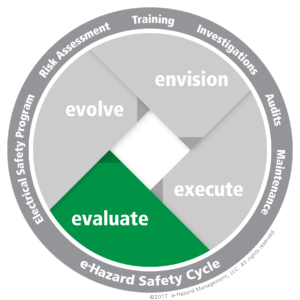Auditing
The e-Hazard Safety Cycle™
As with any important task, checking on progress is critical. The same concept applies to the e-Hazard Safety Cycle™. An audit that is utilized to determine a site’s electrical safety behavior is referred to as the Electrical Safety Audit. This audit is an opportunity to assess the company’s status in regards to adherence to specific electrical safety regulations, NFPA 70E®, and electrical best practice behaviors. These audits can be voluntary, and often are mandated by law per OSHA regulations, or in the case of government or military bases, by DoD or other military regulations (i.e. OPNAV and UFC 3-560-01).
What is Involved in an Electrical Safety Audit?
- 1. Training, including site interviews to determine level of electrical safety knowledge
- 2.Electrical Qualification Process, including Task-Qualification (if used at the site)
- 3. PPE – selection and proper usage
- 4. Shock Hazard awareness
- Understanding the application of safety rules in shock prevention
- Understanding the various boundaries, including Limited Approach, Restricted Approach, Public Safety, and Minimum Approach Distances.
- 5. Arc Flash hazard awareness
- Labeling of site equipment
- If using NFPA 70E® tables, local understanding of how to properly interpret
- 6. Boundary determination (both Shock and Arc Flash) and proper setup
- 7. Electrical Safety tools, including 1000-volt and tools specific to higher voltage applications (shot-gun sticks, insulating blankets, etc.)
- 8. Personnel and program auditing as required by applicable regulations or site policies
Envision: Set Scope,Frequency and Types of Audits
1. In order to manage the incident investigations, an organizational policy is the first step. This document should identify the following:
- Develop a plan for your site(s) to cover all necessary electrical audit categories.
- Ensure the plan provides an easy-to-use format to perform the audit, including audit documentation, appropriate checklists, and a format for the written report.
- Include a site periodicity for the electrical safety audit, and be sure to schedule required personnel to conduct the audit efficiently.


Execute: Perform Audits, based on ESP Protocols
- Kickoff Meeting: 30 minutes
- Document Review: 30 – 90 minutes, based on employee/equipment count
- Site inspection: 30 – 60 minutes based on location size/complexity
- Personnel and Management Interviews: 30-90 minutes based on number of qualified and task-qualified personnel
- Closing Meeting – 30 minutes
Evalute: Review Audit Procedures
The audit process must be revised periodically as changes occur within the industry, including code and standard updates, regulation changes, and updates on electrical Best Practices. Audit protocols, forms, and checklists will need to be updated, site interview questionnaires adapted, and required documentation checklists for the audit adjusted as necessary. These revisions are critical to keep the audit current and appropriate to the location undergoing the auditing process.


Evolve: Update Audit Policies
In NFPA 70E®, the overall electrical safety program requires a three-year audit to “verify the principles and procedures” of the electrical program are still in compliance with the newest NFPA 70E® standard. In the e-Hazard Safety Cycle™, these revisions should be caught in the “Revise” step. However, a periodic review of the electrical audit process needs to be completed to make sure every part of this process is going as planned, sometimes referred to as a “confidence check”. This review should include a trend-analysis based upon all previous audits, and should look at improvements already implemented, missed opportunities, and electrical injury rate trends (specifically shock, burns, and electrical near-misses).
By taking time to review the audit process, the location prepares mentally for the next audit, with specific targets in mind: reducing injuries, correcting unsafe behaviors, and leading personnel to the ultimate goal – a zero-electrical-injury work environment. Only then can the electrical safety cycle truly be called “complete.”
Ready to Get Started?
Join thousands of happy customers who have used our services.





